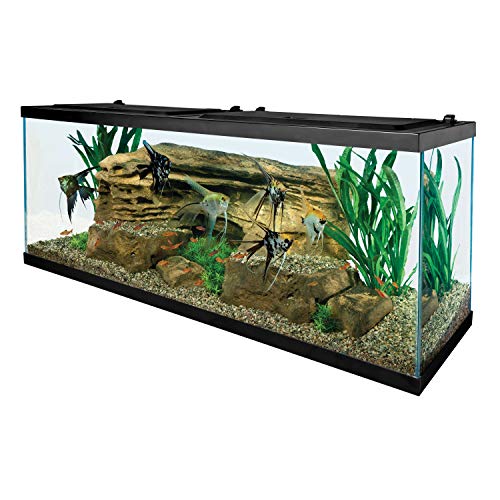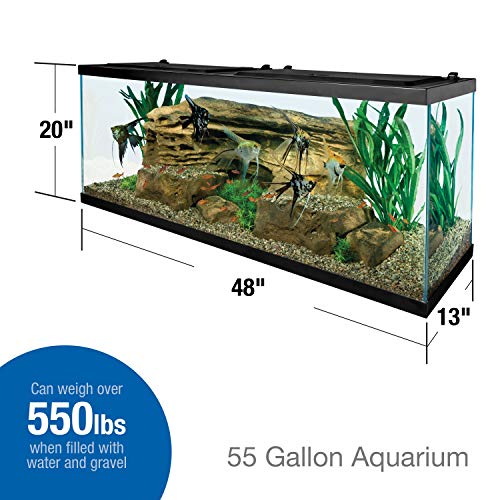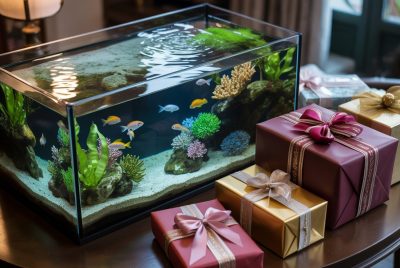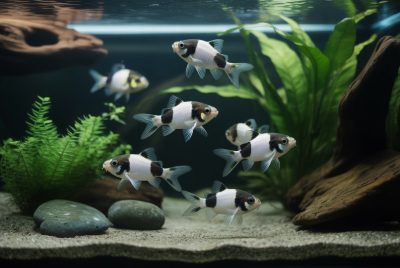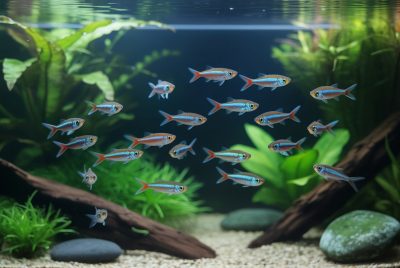The Complete Rainbowfish Care Guide
*We may earn a commission for purchases made using our links. Please see our disclosure to learn more.
I still remember the first time I walked into that local aquarium store, feeling overwhelmed by rows of glass tanks filled with countless fish species. My heart was set on creating the perfect community tank, but I had no idea where to start. Then I saw them – a school of vibrant rainbowfish dancing through the water with their iridescent scales catching the light like living jewels. That moment changed everything about my aquarium journey.
What started as a simple desire for colorful fish evolved into a deep passion for rainbowfish care. Through years of trial, error, and countless hours of research, I’ve learned that these magnificent creatures are far more complex than their peaceful reputation suggests. They have specific needs that, when met properly, reward you with some of the most stunning displays of natural beauty you’ll ever witness in your home.
“Rainbowfish are among the most peaceful and colorful freshwater species, making them perfect centerpiece fish for community aquariums when their specific needs are properly met.”
– Marine Biology Research Institute
Key Takeaways
- Tank Size: Minimum 30 gallons for a small school, with 55+ gallons preferred for optimal health
- Water Parameters: pH 6.5-8.0, temperature 72-78°F, moderate hardness
- Social Needs: Keep in groups of 6+ for natural schooling behavior and stress reduction
- Diet: Omnivorous requiring both high-quality flakes and live/frozen foods for vibrant coloration
- Tank Setup: Heavily planted with open swimming areas and gentle current
- Compatibility: Excellent community fish when paired with similarly sized peaceful species
Recommended Rainbowfish Care Products
1. Tetra Glass Aquarium 55 Gallons
The Tetra Glass Aquarium offers a spacious and durable environment perfect for both beginner and experienced fish keepers. This 55-gallon rectangular tank measures 48"L x 13"W x 20"H, providing ample room for a variety of fish species and aquatic plants. Crafted from high-quality glass, this tank combines strength with clarity to showcase your aquatic life beautifully. Designed for easy customization, it pairs well with Tetra’s wide range of filtration, lighting, and water care products, allowing you to create the perfect aquatic habitat tailored to your needs. Lightweight and modern, this aquarium supports a successful, lifelong aquatic hobby experience.
Spacious 55-gallon tank offering a versatile habitat for community fish and aquascaping. Easily customizable with Tetra accessories for filtration and lighting. Crystal-clear glass construction showcases vibrant aquatic life.
- Size: Spacious 55-gallon capacity offers plenty of room for diverse aquatic setups
- Customization: Compatible with many Tetra accessories for filtration, lighting, and care
- Durability: High-quality glass construction ensures strength and clear visibility
- Accessories: Filtration, lighting, and other equipment sold separately, increasing total cost
- Shape: Narrow depth (13 inches) may limit certain fish or aquascaping styles
- Weight: Although lightweight glass, the filled aquarium still requires sturdy support and setup space
2. API Freshwater Master Test Kit
The API Freshwater Master Test Kit is a comprehensive and trusted solution for monitoring the health of your freshwater aquarium. With the ability to perform up to 800 tests, this kit includes everything you need: 7 bottles of testing solutions, 4 test tubes with caps, and a detailed color chart for accurate readings. It measures five critical water parameters—pH, high-range pH, ammonia, nitrite, and nitrate—ensuring your betta fish lives in clean, safe, and stable water conditions. Regular use of this kit helps prevent invisible water issues that can lead to stress, disease, or even loss of your fish.
Essential for monitoring water parameters. Rainbowfish are sensitive to water quality changes, making regular testing crucial for their health and vibrant colors.
- Comprehensive Testing: Covers all essential water parameters for freshwater tanks.
- Long-Lasting Value: Provides up to 800 tests, making it cost-effective over time.
- Accurate Results: Trusted by hobbyists and professionals for precise water readings.
- Manual Process: Requires measuring and comparing to color charts, which can be time-consuming.
- Storage Space: Comes in a relatively bulky box that may take up tank cabinet space.
- No Digital Display: Lacks digital convenience some modern testers offer.
3. New Life Spectrum Thera A Small 140g
New Life Spectrum Thera A Small is a premium fish food designed to promote health and vitality in a variety of fish species. This Naturox Series formula is packed with high-quality, easily digestible ingredients including whole krill, squid, and seaweed, providing a complete and balanced diet. Enhanced with extra garlic and omega-3s, it supports stressed, newly acquired, or breeding fish while bringing out their natural color. With a high-density nutrition profile, Thera A Small delivers more feedings per jar and reduces waste, making it a smart choice for both hobbyists and professionals.
Specially formulated pellet food for stressed, new, or breeding fish. High-quality ingredients with extra garlic and omega-3s support vitality, while enhancing natural coloration and reducing waste.
- Nutrition: Packed with high-quality, easily digestible ingredients for optimal fish health
- Support: Extra garlic and omega-3s help stressed and breeding fish recover and thrive
- Color Enhancement: Naturally enhances the full spectrum of your fish’s coloration
- Size: Smaller 140g jar may require frequent restocking for larger aquariums
- Price: Premium ingredients make it a bit pricier than basic fish food options
- Feeding Form: Pellet stick form may not be ideal for all fish, especially picky eaters
4. Seachem Flourish Freshwater Plant Supplement
Seachem Flourish is a comprehensive freshwater plant supplement designed to enhance the health and vibrancy of aquatic plants. This 250 ml formula provides a rich blend of essential micro and trace elements such as calcium, magnesium, and iron, supporting lush growth and vivid coloration. Safe for invertebrates and easy to dose, it’s a reliable choice for both beginners and experienced aquarists. Use it in combination with other macro and micro-nutrient supplements to create a thriving planted aquarium.
Plant fertilizer designed for lush, freshwater environments where rainbowfish and other species flourish. Enriches aquatic plants with essential nutrients, ensuring a natural, balanced habitat with stable water chemistry.
- Balanced Formula: Contains a complete mix of essential micro and trace elements for healthy plant growth
- Ease of Use: Simple dosing instructions make it convenient for both beginners and experts
- Safety: Safe for invertebrates like shrimp, making it versatile for diverse tank setups
- Macro Supplement Needed: Should be used with other macro-nutrient products for complete plant nutrition
- Storage: Refrigeration recommended after 3 months, which may not suit all setups
- Inconsistent Color: Solution color may vary by batch, which could confuse users but doesn’t affect performance
My Journey Into Rainbowfish Keeping
The transition from admiring those first rainbowfish to successfully caring for them wasn’t immediate. I made my share of beginner mistakes – housing them in too small a tank, feeding them the wrong foods, and not understanding their social nature. Watching my first school of rainbowfish lose their vibrant colors and become lethargic was heartbreaking. That failure became my greatest teacher.
Through research and connecting with experienced aquarists, I learned that rainbowfish care goes far beyond providing clean water and regular feeding. These fish have evolved in specific environments across Australia and New Guinea, developing unique needs that reflect their natural habitats. Understanding this connection between their wild origins and captive care requirements transformed my approach entirely.
Understanding Rainbowfish: More Than Pretty Colors
The Science Behind Their Beauty
Rainbowfish achieve their stunning coloration through specialized cells called iridophores and chromatophores. These cells reflect light differently based on the fish’s health, stress levels, and environmental conditions. When rainbowfish display their full spectrum of colors, it’s a direct indicator of optimal care conditions.
The intensity of their colors fluctuates throughout the day and during different activities. Males typically display more vibrant hues, especially during breeding displays, while females often show more subtle but equally beautiful coloration patterns. This natural dimorphism adds another layer of visual interest to any aquarium.
Natural Behavior Patterns
In their native habitats, rainbowfish inhabit shallow, heavily vegetated waters with gentle currents. They’re naturally schooling fish, finding safety and comfort in groups. This social structure is crucial to their wellbeing in captivity – solitary rainbowfish or those kept in insufficient numbers often develop stress-related health issues and lose their characteristic vibrancy.
Their feeding behavior in the wild involves constant foraging for small insects, algae, and plant matter. This natural feeding pattern explains why they thrive on frequent, small meals rather than large feeding sessions. Understanding these behavioral traits helps create an environment where rainbowfish can express their natural instincts.
Essential Tank Setup for Rainbowfish Success
Size and Space Requirements
The minimum tank size for rainbowfish is 30 gallons, but this should be considered the absolute minimum for a small group of three to four fish. For optimal health and natural behavior, I recommend starting with at least a 55-gallon tank. This provides adequate swimming space for a proper school of six to eight rainbowfish while maintaining stable water parameters.
Rainbowfish are active swimmers that appreciate horizontal swimming space more than vertical height. A longer, wider tank serves them better than a tall, narrow one. The additional water volume also provides better chemical stability, which is crucial for these somewhat sensitive fish.
Water Parameter Management
Maintaining proper water parameters is perhaps the most critical aspect of rainbowfish care. These fish prefer slightly alkaline to neutral water with a pH range of 6.5 to 8.0. Temperature should remain stable between 72-78°F, with 75°F being optimal for most species.
Water hardness should fall into the moderate range, typically 8-25 dGH. While rainbowfish can adapt to various water conditions, sudden changes can stress them significantly. I learned this lesson the hard way when a large water change with different parameters caused my entire school to lose color and become inactive for weeks.
Regular water testing became part of my weekly routine after that experience. Consistency matters more than achieving perfect numbers – gradual adjustments over time are far better than dramatic corrections.
Filtration and Water Movement
Rainbowfish appreciate gentle water movement that mimics their natural environment. A quality canister filter or hang-on-back filter rated for your tank size will provide adequate mechanical and biological filtration. Avoid creating strong currents that might stress the fish or prevent them from displaying natural behaviors.
The filtration system should turn over the tank volume 4-6 times per hour. This ensures proper oxygenation and waste removal without creating excessive turbulence. Adding an air stone can supplement oxygenation, particularly during warmer months when oxygen solubility decreases.
Creating the Perfect Rainbowfish Environment
Plant Selection and Aquascaping
Heavily planted tanks aren’t just aesthetically pleasing for rainbowfish – they’re essential for their psychological wellbeing. Plants provide security, natural feeding opportunities, and help maintain water quality through nutrient uptake.
I prefer using a combination of background plants like Vallisneria or Amazon swords, mid-ground plants such as Anubias or Java fern, and floating plants like water lettuce. This creates natural sight barriers while maintaining open swimming areas where rainbowfish can school freely.
The key is balancing plant density with swimming space. Too many plants can restrict movement, while too few provide insufficient security. Aim for roughly 60% planted areas with 40% open swimming space.
Substrate and Decoration Choices
Fine sand or smooth gravel works well as substrate for rainbowfish tanks. Avoid sharp or rough substrates that might damage their delicate fins during bottom feeding. A neutral-colored substrate helps showcase their vibrant colors without creating visual competition.
Driftwood and smooth rocks can provide additional visual interest and territorial boundaries. However, ensure any decorations have smooth edges and won’t leach substances that could alter water chemistry. I prefer Malaysian driftwood for its natural appearance and water-softening properties.
Lighting Considerations
Proper lighting serves dual purposes in rainbowfish tanks – supporting plant growth and enhancing fish coloration. LED lighting systems with adjustable intensity work best, allowing you to create subtle lighting variations throughout the day.
Rainbowfish colors appear most vibrant under full-spectrum lighting that includes both warm and cool tones. However, avoid overly bright lighting that might stress the fish or promote excessive algae growth. A photoperiod of 8-10 hours daily provides adequate light for plants while maintaining natural day/night cycles.
Nutrition: Fueling Vibrant Colors and Health
Understanding Rainbowfish Dietary Needs
Rainbowfish are omnivores with specific nutritional requirements that directly impact their coloration and overall health. Their diet should include high-quality protein sources, essential fatty acids, and natural color enhancers like carotenoids.
The foundation of their diet should be a high-quality flake or pellet food specifically formulated for community fish. However, dry food alone won’t maintain their optimal coloration or health. Supplementing with live or frozen foods is essential for bringing out their full potential.
Live and Frozen Food Options
Bloodworms, brine shrimp, and daphnia are excellent protein sources that rainbowfish eagerly consume. These foods provide essential nutrients often missing from processed foods while stimulating natural hunting behaviors.
I rotate between different frozen foods throughout the week – bloodworms on Monday, brine shrimp on Wednesday, and daphnia on Friday. This variety ensures balanced nutrition while keeping feeding time interesting for both the fish and the aquarist.
Live foods like newly hatched brine shrimp or microworms can be particularly beneficial during breeding conditioning or when trying to enhance coloration in new fish. The movement of live prey triggers feeding responses that improve overall activity levels.
Feeding Schedule and Techniques
Rainbowfish benefit from multiple small meals rather than one or two large feedings. I feed my rainbowfish three times daily – morning, afternoon, and evening – offering only what they can consume within 2-3 minutes.
Overfeeding is one of the most common mistakes in rainbowfish care. Excess food decomposes quickly, leading to water quality issues that can dull their colors and compromise their health. It’s better to slightly underfeed than risk pollution from uneaten food.
Varying feeding locations within the tank encourages natural foraging behavior and ensures all fish receive adequate nutrition. Some rainbowfish can be more aggressive feeders, potentially preventing shyer individuals from getting their share.
Social Dynamics and Tank Mates
The Importance of Schooling
Rainbowfish are inherently social creatures that depend on group interactions for psychological wellbeing. A school of six is the minimum recommendation, but groups of eight to twelve display much more natural behaviors and vibrant coloration.
In smaller groups, rainbowfish often appear stressed, lose color intensity, and may develop aggressive tendencies toward tank mates. The security provided by adequate group size allows them to display their full range of natural behaviors while maintaining their stunning appearance.
Compatible Tank Mates
Selecting appropriate tank mates requires understanding rainbowfish temperament and size requirements. They’re generally peaceful but can be boisterous during feeding time or territorial displays. Ideal tank mates include similarly sized peaceful species that won’t compete aggressively for food.
Corydoras catfish make excellent bottom-dwelling companions, cleaning up uneaten food while occupying different tank levels. Peaceful barbs, tetras, and other rainbow species can create stunning community displays when properly managed.
Avoid housing rainbowfish with aggressive species, very small fish that might be seen as prey, or slow-moving fish that struggle to compete for food. Cichlids, large angelfish, and most Central American species are generally incompatible.
Managing Territorial Behavior
While generally peaceful, male rainbowfish can display territorial behavior, particularly during breeding periods. Providing adequate space and visual barriers helps minimize conflicts while allowing natural hierarchy establishment.
Rearranging decorations occasionally can reset territorial boundaries if aggression becomes problematic. However, frequent changes can stress fish, so this should be used sparingly and only when necessary.
Common Challenges and Solutions
Color Fading Issues
Perhaps the most frustrating problem rainbowfish keepers face is watching their vibrant fish gradually lose their brilliant coloration. This issue usually stems from stress, poor nutrition, or suboptimal water conditions rather than disease.
When my rainbowfish began losing their vibrant hues, I systematically addressed each potential cause. First, I tested and corrected water parameters, then upgraded their diet with more varied protein sources. Within weeks, their colors began returning to their full intensity.
Stress-induced color loss often occurs when fish are kept in inadequate group sizes, inappropriate tank mates, or unstable environments. Addressing the root cause rather than treating symptoms typically resolves color issues permanently.
Water Quality Fluctuations
Rainbowfish are surprisingly sensitive to water quality changes despite their reputation for hardiness. Maintaining stable parameters requires consistent maintenance schedules and appropriate filtration for your bioload.
I learned to perform smaller, more frequent water changes rather than large weekly changes. Changing 15-20% of the water twice weekly maintains better stability than removing 40% once weekly. This approach prevents the parameter swings that can stress rainbowfish.
Breeding Behavior Management
Rainbowfish breeding behavior can disrupt tank harmony if not properly managed. Males become more territorial and colorful during breeding displays, which can stress tank mates and create aggression issues.
Providing dense plant cover gives fish places to retreat from aggressive displays while allowing natural behaviors to occur. If breeding becomes disruptive, temporarily removing the most aggressive males can restore peace while allowing the behavior to run its course.
Health Monitoring and Disease Prevention
Recognizing Early Warning Signs
Healthy rainbowfish display bright colors, active swimming patterns, and eager feeding responses. Changes in any of these behaviors often indicate developing health issues before visible symptoms appear.
I monitor my fish daily during feeding time, watching for changes in appetite, swimming patterns, or social interactions. Early intervention prevents minor issues from becoming serious health problems that could affect the entire tank.
Common early warning signs include reduced feeding enthusiasm, isolation from the school, fin clamping, or subtle color changes. Addressing these symptoms quickly often prevents disease progression and reduces treatment requirements.
Preventive Care Strategies
Prevention remains the most effective approach to rainbowfish health management. Maintaining optimal water quality, providing varied nutrition, and minimizing stress factors prevent most health issues before they develop.
Quarantining new fish for 2-4 weeks before introducing them to your main tank prevents disease transmission while allowing observation of new additions. This practice has saved my established fish from several potential disease outbreaks over the years.
Regular tank maintenance, including filter cleaning, water changes, and parameter testing, creates an environment where rainbowfish can thrive naturally without requiring frequent medical interventions.
Seasonal Care Considerations
Temperature Management
While rainbowfish tolerate temperature variations better than many tropical species, maintaining consistency improves their overall health and coloration. Seasonal temperature fluctuations can trigger breeding behaviors or stress responses that affect tank dynamics.
During summer months, I monitor tank temperatures more closely and use fans or chillers if necessary to prevent overheating. Conversely, winter heating bills led me to invest in more efficient heaters that maintain stable temperatures economically.
Breeding Season Behaviors
Many rainbowfish species exhibit increased breeding activity during certain seasons, even in captivity. Understanding these natural cycles helps predict and manage behavioral changes that might affect tank harmony.
Increased plant growth during longer daylight periods provides more security for fish while potentially affecting nutrient levels. Adjusting fertilization schedules and pruning routines accommodates these seasonal changes while maintaining tank balance.
Advanced Care Techniques
Water Chemistry Fine-Tuning
As your experience grows, fine-tuning water chemistry can enhance rainbowfish coloration and breeding success. Gradually adjusting pH, hardness, and trace elements to match specific species requirements often produces remarkable improvements in fish appearance and behavior.
I use reverse osmosis water mixed with treated tap water to achieve precise parameters for different rainbowfish species. This level of control requires more effort but rewards dedicated aquarists with superior fish health and coloration.
Breeding and Fry Care
Successfully breeding rainbowfish requires understanding their specific spawning requirements and fry development needs. Most species scatter eggs among fine-leaved plants over several days, requiring separate breeding setups for optimal success.
Raising rainbowfish fry demands patience and attention to detail. Newly hatched fry require infusoria or liquid fry food before transitioning to newly hatched brine shrimp. The time investment is significant, but watching tiny fry develop into colorful adults provides immense satisfaction.
Building Your Rainbowfish Community
Species Selection Strategies
Different rainbowfish species have varying care requirements and compatibility considerations. Researching specific species needs before purchasing prevents problems while ensuring optimal conditions for each fish type.
I prefer starting with hardier species like Boesemani or Australian rainbowfish before attempting more challenging varieties. This approach builds experience while establishing successful systems that can accommodate more demanding species later.
Long-term Planning
Planning for your rainbowfish community’s future growth and changing needs prevents problems before they develop. Consider adult sizes, breeding potential, and aging infrastructure when designing your system.
My original 55-gallon setup eventually grew into a 125-gallon display tank as my rainbowfish collection expanded. Planning for this growth from the beginning would have saved money and reduced fish stress during transitions.
The Emotional Rewards of Rainbowfish Keeping
Daily Observations and Connections
The daily ritual of observing rainbowfish behavior creates connections that extend beyond simple pet ownership. Watching their social interactions, feeding responses, and color changes throughout the day provides ongoing entertainment and educational opportunities.
Each fish develops individual personality traits that become apparent over time. Some are bolder feeders, others prefer specific tank areas, and certain individuals often initiate schooling movements. These observations deepen appreciation for their complex social structures.
Sharing the Passion
Connecting with other rainbowfish enthusiasts through online forums, local clubs, or aquarium societies enhances the hobby experience while providing valuable learning opportunities. Sharing successes and challenges with fellow hobbyists creates lasting friendships based on common interests.
I’ve found that helping newcomers experience their first successful rainbowfish display provides as much satisfaction as my own achievements. The hobby grows stronger when experienced keepers share knowledge generously with those just beginning their journey.
Conclusion
My journey with rainbowfish began with simple aesthetic appreciation but evolved into a deep understanding of their complex needs and rewarding care requirements. These magnificent fish offer far more than beautiful colors – they provide daily reminders of nature’s incredible diversity and the satisfaction that comes from successfully meeting another species’ needs.
The challenges I faced early in my rainbowfish keeping journey taught valuable lessons about patience, observation, and the importance of understanding natural behaviors. Every mistake became a learning opportunity that improved my care techniques and deepened my appreciation for these remarkable fish.
Whether you’re just beginning your rainbowfish journey or looking to improve your current setup, remember that success comes from understanding their specific needs rather than applying generic fish care principles. Take time to observe their behaviors, maintain consistent water quality, and provide the social environment they require for optimal health.
Your dedication to proper rainbowfish care will be rewarded with daily displays of natural beauty that never lose their ability to inspire wonder and appreciation for the aquatic world. The investment in time, effort, and resources pays dividends in the form of vibrant, healthy fish that bring joy and tranquility to your daily routine.
Start with quality equipment, maintain consistent care routines, and don’t be afraid to ask questions or seek advice from experienced keepers. Your rainbowfish are depending on you to provide the best possible care, and with dedication and patience, you’ll create an aquatic display that showcases these incredible fish at their absolute finest.
Frequently Asked Questions
Q: How many rainbowfish should I keep together in a 40-gallon tank?
A: For a 40-gallon tank, I recommend keeping 6-8 rainbowfish maximum. This provides adequate swimming space while maintaining the social group size they need for optimal behavior and coloration. Overcrowding leads to stress and water quality issues that can compromise their health and vibrant colors.
Q: Why are my rainbowfish losing their bright colors?
A: Color loss in rainbowfish typically indicates stress from poor water quality, inadequate diet, insufficient group size, or incompatible tank mates. Check your water parameters first, ensure you’re feeding varied high-quality foods including frozen options, and verify you have at least 6 fish in your school. Colors usually return within 2-4 weeks once conditions improve.
Q: Can rainbowfish live with angelfish in a community tank?
A: While both species can coexist peacefully, it depends on the specific angelfish temperament and tank size. Adult angelfish may view small rainbowfish as prey, while large rainbowfish might stress angelfish during feeding. A 75+ gallon tank with plenty of plants and hiding spots improves compatibility, but monitor interactions closely initially.
Q: How often should I feed my rainbowfish and what foods work best?
A: Feed rainbowfish 2-3 small meals daily rather than one large feeding. Offer high-quality flakes or pellets as the staple diet, supplemented with frozen bloodworms, brine shrimp, or daphnia 2-3 times weekly. This feeding schedule maintains optimal health while enhancing their natural coloration through varied nutrition.
Q: What water temperature range is ideal for rainbowfish health?
A: Maintain water temperature between 72-78°F (22-26°C), with 75°F (24°C) being optimal for most species. Avoid temperature fluctuations greater than 2-3 degrees daily, as rainbowfish are sensitive to sudden changes. Use a reliable heater and consider a backup during winter months to prevent temperature crashes that can stress or kill your fish.



